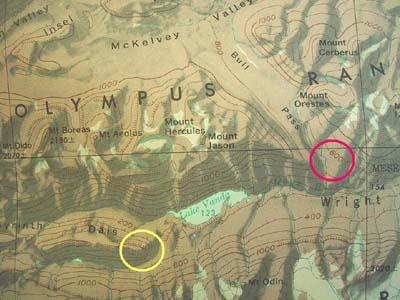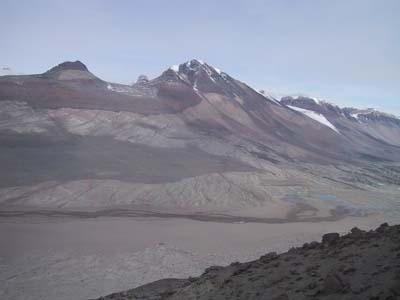
|
|
10 January, 2003
Dais
When the Dry Valleys formed, magma came up in columns and, at the top,
capped and spread out to form sills. The Dais is a major regional feeder of
this magma. It gets its name from a flat table or podium. The Dais is
located about 8 miles from the Bull Pass camp and will be a major area we
will investigate.
The central science theme then is to try to describe the basic magmatic
system that is responsible for this area of Antarctica. Because the Dry
Valleys are not overrun by vegetation or eroded by rain, the "plumbing"
which formed the region is exposed and provides an outstanding model for
magmatic systems all over the world. While these systems could be explored
elsewhere, nowhere is this type of exposure so prevalent and pristine as it
is here. The major sills in the Dry Valleys are known as the Basement Sill,
the Peneplain Sill, the Asgaard Sill, and the Flemming Sill. The Basement
and Peneplain sills are the ones we've seen the most.
From north to south, the three main Dry Valleys are Victoria (and a branch
known as McKelvey Valley), Wright, and Taylor. Bull Pass is located between
McKelvey and Wright Valley. The air is so dry in the Dry Valleys, which
cover about 1200 square miles, that they have virtually no snow or ice. Such
ice-free areas in Antarctica are called oases. The conditions required for
an oasis are a retreating or thinning ice sheet, and a large area of exposed
rock from which snow becomes ablated due to solar radiation absorbed by the
rock. Oftentimes we have observed the heat emanating from the rocks similar
to what you might observe from the surface of a road in the summer.
The Dry Valleys were formed when the terrain uplifted at a faster rate than
the glaciers could cut their way down through them. Eventually, the glaciers
were stopped by high necks at the head of each valley.
Robert Scott accidentally discovered the first of the Dry Valleys in
December 1903 and named it for geologist Griffith Taylor. Scott and two
others had sledged up the Ferrar Glacier to the East Antarctic Ice Sheet. On
their return, they became lost in thick cloud and descended the wrong
valley. Because they were equipped for sledging, not hiking, they were
forced to turn back after a brief exploration. In The Voyage of the
Discovery, Scott wrote: "I cannot but think that this valley is a very
wonderful place. We have seen today all the indications of colossal ice
action and considerable water action, and yet neither of these agents is now
at work. It is worthy of record, too, that we have seen no living thing, not
even a moss or a lichen; all that we did find, far inland amongst the
moraine heaps, was the skeleton of a Weddell seal, and how that came here is
beyond guessing. It is certainly a valley of the dead; even the great
glacier which once pushed through has withered away."

1. The Dais (yellow circle) is located about 8 miles from our camp in Bull Pass (red circle)

2. Sills are the horizontal dark bands and generally store magma. Dikes are the somewhat vertical bands which transport magma. Magma is molten Earth. This region of Antarctica is not volcanically active but Mt Erebus, on Ross Island not too far from McMurdo, is. In fact, Mt Erebus is one of the largest active volcanoes in the world. Crystals at the upper rim of Erebus are anorthoclase feldspar and represent some of the largest and most prefect crystals associated with volcanic rock anywhere in the world.
Contact the TEA in the field at
.
If you cannot connect through your browser, copy the
TEA's e-mail address in the "To:" line of
your favorite e-mail package.
|
